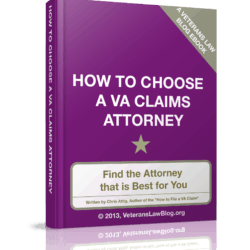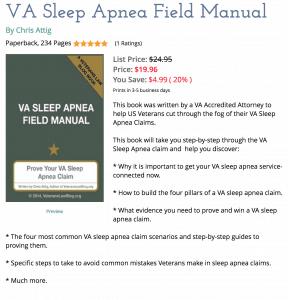What is a claim for increased rating?
When the VA grants service connection for your service connected disability, it will assign an initial rating. However, medical conditions are rarely static, and will frequently – almost always – get worse.
So, when your service-connected medical condition or disability gets worse, you may want to consider filing a claim for an increased rating and seek a higher disability rating
Here are 6 scenarios where you might want to consider filing a VA disability claim for an increased rating:
- You have found new evidence that your a medical condition related to military service has deteriorated or worsened.
- You believe your condition has gotten worse since your last VA disability rating.
- You think the VA lowballed your initial rating
- Your medical condition has caused another medical condition
- You are unable to get and keep substantially gainful employment due to your service-connected disabilities.
- You believe you are entitled to Special Monthly Compensation.
You need to know more than what the VA will tell you.
If you consult the VA.gov website, they will make it seem super easy to file a claim for increased rating. And, to be honest, it is rather easy when done right.
But the steps on the VA.gov website, if you follow them, will most likely lead to a denial of an increased rating, in all but the most obvious of scenarios.
Why? Because the VA’s information on filing a supplemental claim for increase is sparse, simplistic, and not consistent with how they process and evaluate supplemental claims for increased VA disability ratings.
Here’s what the VA will tell you is all you need to do to prepare an application for increased disability compensation:
- Find out if you’re eligible for VA disability compensation.
- Gather any evidence (supporting documents) you’ll submit yourself when you file your disability claim.
- Be sure your claim is filled out completely and you have all the supporting documents ready to send in along with your claim. This will help us process your claim quickly.
- Find out if you’ll need to turn in any additional forms with your claim.
While this is a nice superficial summary of what can be done to seek an increased rating, I promise you it is not enough.
The VA puts just enough information to make it look like they are being reasonable and helpful – just enough to make it look like requesting an increase of your disability rating is easy.
In reality, the information on the VA website is completely unhelpful, and often damaging, to veterans seeking increased disability compensation ratings.
The rest of the post will tell you the “real deal” for seeking an increased disability compensation rating.
Even still, this post is just the tip of the iceberg, and it is no substitute for legal advice from an attorney or VA law firm that knows the particulars of your VA claim or appeal.
What evidence do I need to file a VA disability claim for an increased rating?
This is a tough question to answer, and this is not a post about evidence, so I’m going to hit only the proverbial “high notes.”
Generally, you will want to maximize evidence that proves the increase in severity of your symptoms by submitting the following types of evidence
- Evidence that establishes the increase in frequency, severity and chronicity of the symptoms of your condition that are found in the rating criteria for your condition in the VA’s Schedule of Ratings. If your symptoms are not on that list, but are getting more severe and are affecting your earning capacity, be sure to consider asking for a “rating by analogy” or an “extra-schedular rating.”
- Lay, Medical and Expert evidence. Use all three kinds of evidence. Lay evidence can change the outcome of your claim – it is a silver bullet that most disabled veterans do not tae full advantage of. Your medical records and other medical evidence can come from a VA doctor or a private doctor. And, if you use medical expert evidence, be sure it has the “magic words.” And, if the VA uses medical expert evidence against you, be sure to challenge its competency using the information on this page.
- 5-star evidence – Evidence that will establish a higher rating must meet the ‘5-star’ standard that I talk incessantly about on the Veterans Law Blog®.
What form do I use to file a Claim for Increased Rating?
This depends on the scenario in which you are seeking an increased rating.
If it has been more than one year from the most recent ratings decision involving the medical condition for which you seek an increased disability rating, and you have filed nothing with the VA in the first year after that prior ratings decision, then you will want to file one of the following two types of claims:
Option A – Supplemental Claim for Increase (because the supplemental claim is not within one year of the prior VA ratings decision, then the VA will ultimately find that you have not “continuously pursued” your claim/appeal, and so your effective date will be the earliest date that an increase in severity of the condition can be established, up to one year before the supplemental claim. If you are filing a supplemental claim for increased disability compensation OUTSIDE the one-year period, use VA Form 21-526-EZ (click here for the link to the VA Form 21-526-EZ as of May 2019. ALWAYS be sure to check with the VA that you are using the correct form.)
Option B – File a Claim to revise an earlier final ratings decision based on Clear and Unmistakeable Error (aka, a CUE claim). I hesitate to mention this option, because veterans file CUE claims as frequently as the Dave Matthews Band goes on tour: far too much. In all seriousness, the CUE claim is a claim of last resort, and should only be used when there is no other option. And, under the Supplemental claim process, there is always an option to increase the rating for current compensation purposes, and save the CUE claim to attack the final and “no-longer-appealable” denial of an appeal for an earlier effective date. Now, this isn’t the only time that you would file a CUE claim, but veterans need to stop filing these so frequently. They are missing out on better and more effective processes by wasting their time trying to prove the hardest claim in the VA catalog.
If you are within one year of the most recent VA ratings decision involving the medical condition for which you seek an increased disability rating, then the proper approach to this is to file one of the following:
Option #1: Supplemental Claim for Increased Rating
The Supplemental Claim for Increase – when used to challenge a ratings decision within one year – is filed using VA Form 20-0995. The only difference between a supplemental claim for increased rating filed within a year of the most recent VA ratings decision on that same condition and a supplemental claim for increased rating filed more than a year after the most recent VA ratings decision on that same condition is that the supplemental claim for increase filed within a year of the last VA ratings decision is considered “continuously pursued” and could lead to an earlier effective date.
Technically, you are going to be adding “new and relevant” evidence to a claim, and you are going to want to use VA Form 20-0995 to file this claim (as of February 2019, anyway. ALWAYS be sure to double check with the VA that you are using the correct form).
Option #2: Notice of Disagreement and Appeal to the BVA.
If you file a Notice of Disagreement and appeal to the BVA, then be sure to use the current Notice of Disagreement form. The VA is rejecting appeals that use outdated Notice of Disagreement forms. Another way that the VA has made it easier on veterans – know you have to comb through their maze of a website to find out if the form they want you to use is the current form, and you only find out when they send you notice that they are rejecting your firm. Veterans first, right?
Also, if you file a Notice of Disagreement and appeal to the BVA, think long and hard about which “hearing/evidence lane” you want. Remember, there are three.
Here is a quick reminder of the three lanes:
Direct Appeal Docket (Direct Docket): This lane is for veterans who do not want to submit either evidence or argument, and do not want to attend a hearing before a BVA Veterans Law Judge. The BVA will look only at the evidence that was in the file when the appealed decision was issued. Theoretically, this type of appeal is going to be decided in 365 days by the BVA, but I doubt that will come to pass. More important, this option is not entirely different from the Higher Level Review process listed below.
Hearing Docket: This lane is for veterans who want a hearing before the BVA. You will get either a video conference hearing or a hearing at the BVA in Washington DC. Unless your appeal is a “legacy appeal” you will not get a “Travel Board” hearing.
Evidence Docket: If you want to submit evidence but do not want a hearing before the BVA, you might consider this docket. You can submit evidence to the BVA with your notice of disagreement, or within a set time period after the BVA decision.
Option #3: Higher Level Review.
The Higher Level Review is a review of your claim by a rating specialist who is more experienced than the one who initially rated your claim. It is not the same as a Decision Review Officer (DRO) under the Legacy system. At the DRO conference, you could introduce evidence and argument. In a Higher Level Review, you cannot. Think of the Higher Level Review process like you are passing your claim to an unknown person behind a curtain. You’ll get either a yes or no answer, with little or no explanation.
As it turns out, and I know you will be shocked to hear this, but the Higher Level Review is pretty much useless. As the saying goes here in Arkansas, it’s as “worthless as a tit on a boar hog.” #WPS
In all seriousness, the reviews of the Higher Level Review process seems to be that your time is better spent doing anything else. I’ve not met anyone – lawyer or vet – who has had a good experience with Higher Level Review. While it’s early in the AMA process, and things can change, we all know that with the VA things never really do change.
Will the VA reduce my other ratings?
The conventional wisdom says that anytime we ask the VA to open our file and adjust a rating, we open ourselves up to a complete review of all ratings. Conventional wisdom says “don’t file a claim for increase unless you know you can win.”
It is crap like this that keeps many a veteran from taking control of their VA claim, telling the VA what VA disability benefits they need, and going out and getting those benefits.
It’s “conventional wisdom” like this that keeps veterans trapped in a culture of “learned helplessness” when it comes to their benefits.
It does happen, don’t get me wrong. But when we know things can happen, we prepare for them.
The VA has to follow some pretty significant steps to reduce a rating, and though the law has never gotten in their way, it does tend to come back and bite the VA in the proverbial butt when they wrongfully downgrade a veteran’s rating in retaliation for seeking an increased rating.
If you believe you are entitled to an increase disability rating, then file the supplemental claim, provide the 5-star evidence to support it, and be prepared to prove and defend your claim.
Will filing a claim slow down my other claims and appeals?
Another myth told to veterans to discourage them from seeking additional disability compensation. I have yet to see any hard proof that filing a claim for increase will delay the processing of other claims and appeals.
As with all myths, there is an element of truth. The problem is that the element of truth is blown way out of proportion, becomes the story that is told, and the truth is buried.
Here’s the kernel of truth in this myth.
It used to be under the Legacy system that significant delay could result when a veteran filed a claim for increased rating on a condition where another claim for increased rating of the same condition was already on appeal, or when a veteran filed a claim for an increased rating before the VA granted service connection (yes, this happened quite frequently), or when a veteran filed a CUE claim while a traditional claim or appeal on the same issue was being processed.
But I’ve seen no evidence that filing a supplemental claim for an increased rating will delay any other claim or appeal. In fact, the structure of the AMA process seems to cut against this likelihood. If that changes, though, I will be the first to tell you.
What is the effective date for a claim for increase?
Remember that the effective date general rule says that the effective date for your disability compensation rating is the later of the date the VA receives the claim or the date the entitlement arose.
And the VA often tries to apply this general effective date rule to VA increased rating claims.
But the VA is often wrong.
A veteran is entitled to an effective date equal to the date the Veteran establishes that the severity of his or her symptoms began to worsen, up to one (1) year before the date the VA claim for increased disability rating is filed.
Read the increased rating effective date statute here – 38 U.S.C. §5110(b)(2) – in the United States Code.
8 General Steps to filing a VA Claim for increased rating.
- Look up your disability’s rating table in the VA’s schedule of ratings.
- Identify what symptoms you will need to show to prove the next higher rating level.
- If you have those symptoms, go out and get 5 star lay and medical evidence proving those symptoms.
- Your proof of your symptoms, in addition to the 5 stars all evidence requires, should show the VA the frequency, chronicity and severity of your symptoms, as well as when they first started getting worse.
- If the symptoms that support a higher rating for your condition are things only a doctor can test for or observe, then you may want to consider getting a medical opinion that explains the measurement of the increase in severity of your symptoms.
- Fill out the proper VA Form to seek a supplemental claim for an increase rating in the scenario most appropriate to you (there are several different types of “supplemental claim forms” – ALWAYS verify with the VA that you are filing the right form, as they are playing a lot of “gotcha” games with their forms right now.
- Gather your evidence, organize it in a logical fashion, provide a cover memo explaining how your symptoms match up to the increased rating criteria, where the VA can find that evidence in your submission.
- Send the VA Form CITE and the evidence to the Evidence Intake Center – certified mail return receipt requested is the method I recommend so that you can always control the proof of service and the proof of receipt.
If you have questions about the process for seeking an increased VA Disability rating, post them in the comments below and I will work to answer as many as I can.






Actually I and 2 of my clients that I put in for HLR were granted our claims. You have to know that the evidence is in your cfile when you do a HLR. I think it was very misunderstood in RAMP. It is basically a CUE. I just put one in last week. Hopefully it goes as well as the others I put in.
Hi Wanda,
That’s great news. You hit the nail on the head – if you don’t know what is in your C-File at the time of the decision, the HLR process is probably not going to be effective.
Good job!
Chris